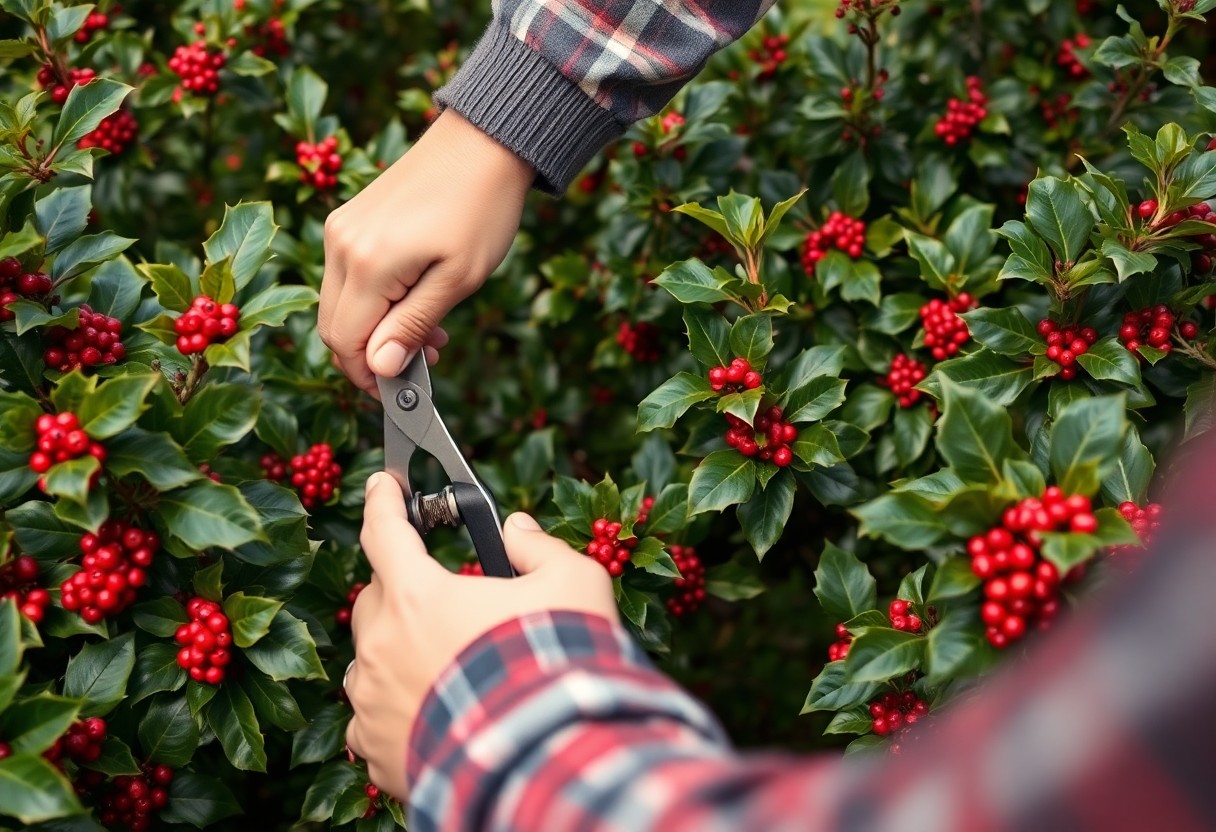
Just like any other beautiful plant, your hollies can benefit from a little TLC through pruning! With the right techniques, you can keep your hollies healthy and vibrant while shaping them to fit your garden’s aesthetic. In this guide, you’ll discover all the tips you need to make pruning a breeze, from timing and tools to the best practices for maintaining their lush foliage. Let’s probe how to give your hollies the care they deserve!
Understanding Hollies
To truly appreciate hollies, it’s important to understand their characteristics and potential in your garden. These evergreen shrubs and trees offer beautiful foliage and vibrant berries, providing year-round interest and habitat for wildlife. Their adaptability allows them to thrive in various climates and soil types, making them a versatile choice for your landscape. By recognizing the unique features of hollies, you can select the right varieties and care techniques to keep them healthy and attractive.
Choosing the Right Holly Varieties
Now that you know the basics, it’s time to explore the different holly varieties available. Each type has its own unique appearance, growth habits, and requirements, so consider your space, climate, and aesthetic preferences. Whether you want a tall, stately tree or a compact shrub, there’s a holly that can fit seamlessly into your garden. Take your time to research and choose wisely to ensure your hollies will thrive in your outdoor space.
The Importance of Timing
Varieties of hollies can be sensitive to the timing of pruning, which influences their health and growth. Each type may have a specific window for optimal trimming, often determined by their growth cycles. Pruning at the right moment ensures you maintain their shape and promote robust berry production while avoiding stress on the plants. Careful planning will lead to healthy plants that flourish in your garden.
Importance of timing in pruning hollies cannot be overstated, as it directly impacts the overall vitality of your plants. Pruning during their dormant season, typically in late winter to early spring, allows them to recover from the process and encourages new growth when the weather warms up. Conversely, if you prune too late in the growing season, you may risk removing buds that will produce berries, or cause unnecessary stress. By understanding the optimal timing for your specific holly varieties, you set the stage for a thriving and beautiful landscape.
Essential Pruning Tools
Even the most seasoned gardeners need the right tools to effectively prune hollies. Having the right equipment not only makes the task easier but also ensures you achieve the best results for your plants. Investing in high-quality tools will save you time, effort, and frustration while preserving the health and beauty of your hollies.
Must-Have Equipment
Some crucial tools you’ll need include sharp hand pruners for small branches, loppers for thicker ones, and a pruning saw for larger limbs. A pair of gloves is also beneficial to protect your hands from prickly leaves. Having these basic tools on hand will empower you to tackle your pruning tasks efficiently.
Tool Maintenance Tips
Any gardener knows that keeping your tools in top shape extends their lifespan and effectiveness. Regular maintenance such as cleaning, sharpening, and oiling can make a significant difference. Here are some quick tips to help you maintain your equipment:
- Wipe blades after each use to remove sap and dirt.
- Sharpen blades regularly to ensure clean cuts.
- Oil moving parts to prevent rust and stuck mechanisms.
Knowing how to care for your tools will ensure they serve you well for many years.
Plus, maintaining your tools not only enhances their performance but also makes your pruning tasks smoother and more enjoyable. By keeping your tools in great condition, you’ll find that your hands will tire less quickly and that you can make more precise cuts. Here are a few more maintenance tips to keep in mind:
- Inspect tools for damage before use.
- Store tools in a dry place to avoid rust.
- Replace worn-out parts as needed.
Knowing these simple maintenance practices can maximize your gardening experience while ensuring your hollies thrive!
How to Prune Hollies
Any time you prune your hollies, you’ll encourage healthy growth and maintain their beautiful shape. This process not only enhances their appearance but also promotes better fruit production and overall sturdiness. Timing is vital, so be sure to prune your hollies during the late winter or early spring before new growth appears. By following proper techniques, you can ensure your hollies thrive and remain an attractive part of your landscape.
Step-by-Step Pruning Techniques
Even if you’re new to gardening, pruning hollies can be straightforward. Here’s a simple breakdown to guide you through the process:
| Step | Description |
| 1 | Identify and remove dead or damaged branches. |
| 2 | Thin out crowded areas to improve air circulation. |
| 3 | Shape the plant to your desired form, cutting just above a leaf node. |
| 4 | Step back to assess the overall shape and make adjustments if needed. |
Common Mistakes to Avoid
Any gardener can fall into common traps when pruning hollies. Avoid cutting too much at once, as this can stress your plant and lead to unhealthy regrowth. Timing is also important—pruning too late in the season can harm new buds, reducing blooms and berries for the next year. It’s best to stay patient and observe your plant’s natural shape to prune effectively.
Another thing to watch out for is improper tool usage. Make sure your tools are sharp and clean to prevent any damage or disease transmission to your hollies. Taking your time and ensuring your cuts are precise will help your hollies flourish and stay beautiful in your garden. Enjoy the process of maintaining these lovely plants!
Tips for Successful Pruning
Despite the challenges that come with pruning hollies, following a few simple tips can make the process more effective. Keep in mind:
- Always use clean, sharp tools to prevent disease.
- Prune during the dormant season for better growth.
- Avoid heavy pruning; aim for light, selective cuts.
- Ensure your cuts are angled to promote healing.
Thou can achieve beautiful hollies with care and attention!
Best Practices
Little adjustments can lead to stunning results when pruning your hollies. Start by assessing the plant’s overall shape and size, focusing on areas that need trimming. Always work to enhance the natural growth habit of the plant for the best appearance.
Seasonal Care Tips
On top of pruning, providing seasonal care is important for healthy hollies. Here are some helpful tips:
- Mulch around the base to retain moisture.
- Water during dry spells to keep roots hydrated.
- Fertilize in early spring for robust growth.
Assume that a little extra attention will reward you with lush greenery!
Seasonal care is all about timing and attention to detail. Regularly check for pests and diseases, and don’t hesitate to take action if you spot any issues. For the best results, maintain a consistent watering schedule and ensure proper drainage. Here are a few more tips:
- Avoid over-fertilization to prevent burning the roots.
- Take note of any changes in leaf color or growth pattern.
- Provide adequate space for airflow to minimize disease risk.
Assume that following these care tips will help your hollies thrive year after year!
Factors Affecting Holly Growth
Not all hollies thrive under the same conditions. Several factors can impact their growth potential, including:
- Soil quality
- Sunlight exposure
- Water availability
- Temperature fluctuations
Thou need to pay attention to these elements to ensure your hollies flourish.
Environmental Considerations
Affecting the growth of hollies involves considering the environment in which they are planted. Factors like soil drainage, pH levels, and exposure to wind directly influence their health. Ensuring a balanced ecosystem for your hollies will help them produce lush foliage and vibrant berries.
Common Pests and Diseases
For your hollies, awareness of common pests and diseases can prevent significant damage. Pests like aphids and scale insects often invade, while diseases such as leaf spots and root rot can compromise their strength.
Diseases can quickly spread if not addressed, leading to stunted growth and yellowing leaves. Keeping an eye out for symptoms and maintaining good hygiene in your garden will help minimize risks. Regularly inspect your plants and provide appropriate care to keep your hollies looking their best.
Aftercare for Pruned Hollies
For optimal growth post-pruning, it’s important to provide your hollies with proper aftercare. This includes ensuring they are well-watered and monitoring their recovery as they bounce back from their trim. Taking these steps will help keep your plants healthy and vibrant as they regain their lush appearance.
Watering and Fertilization
Hollies benefit from consistent watering, especially after pruning. Make sure to water your plants deeply but infrequently, allowing the soil to dry out between waterings. You may also consider adding a balanced fertilizer to promote healthy regrowth, but be cautious not to over-fertilize, as this may harm your plants.
Observing Recovery
Any signs of new growth should be seen within a few weeks after pruning. Watch for fresh leaves and branches sprouting, as this indicates that your hollies are recovering well. You might also notice your plants becoming more vibrant, which is an encouraging sign of their strength and vitality.
Another approach to observing recovery is to keep track of the overall appearance of your hollies. Pay attention to any discolored leaves or unusual growth patterns, as these may signal issues that need your attention. With regular monitoring, you’ll be in tune with your plants’ needs and can ensure they flourish beautifully after their pruning session.
Summing up
Taking this into account, pruning your hollies can be a rewarding task that enhances their beauty and health. By assessing their growth, choosing the right time, and using clean tools, you can maintain their shape and encourage new growth. Don’t hesitate to remove any dead or diseased branches, as this allows your plant to thrive. With a little care and attention, your hollies will continue to flourish in your garden for years to come!







